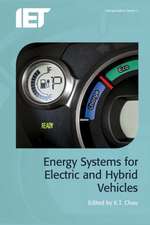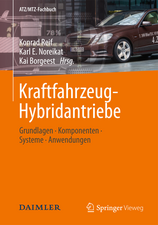Vehicular-2-X Communication: State-of-the-Art and Research in Mobile Vehicular Ad hoc Networks
Autor Radu Popescu-Zeletin, Ilja Radusch, Mihai Adrian Riganien Limba Engleză Paperback – 23 sep 2014
| Toate formatele și edițiile | Preț | Express |
|---|---|---|
| Paperback (1) | 631.72 lei 43-57 zile | |
| Springer Berlin, Heidelberg – 23 sep 2014 | 631.72 lei 43-57 zile | |
| Hardback (1) | 637.93 lei 43-57 zile | |
| Springer Berlin, Heidelberg – 12 mai 2010 | 637.93 lei 43-57 zile |
Preț: 631.72 lei
Preț vechi: 743.20 lei
-15% Nou
Puncte Express: 948
Preț estimativ în valută:
120.90€ • 125.75$ • 99.81£
120.90€ • 125.75$ • 99.81£
Carte tipărită la comandă
Livrare economică 14-28 aprilie
Preluare comenzi: 021 569.72.76
Specificații
ISBN-13: 9783642426056
ISBN-10: 3642426050
Pagini: 120
Ilustrații: VI, 112 p.
Dimensiuni: 155 x 235 x 6 mm
Greutate: 0.18 kg
Ediția:2010
Editura: Springer Berlin, Heidelberg
Colecția Springer
Locul publicării:Berlin, Heidelberg, Germany
ISBN-10: 3642426050
Pagini: 120
Ilustrații: VI, 112 p.
Dimensiuni: 155 x 235 x 6 mm
Greutate: 0.18 kg
Ediția:2010
Editura: Springer Berlin, Heidelberg
Colecția Springer
Locul publicării:Berlin, Heidelberg, Germany
Public țintă
ResearchCuprins
Applications of Vehicular Communication.- Communication Regimes.- Information in the Vehicular Network.- Routing.- Medium Access for Vehicular Communications.- Physical Layer Technologies.- Security.
Notă biografică
Radu Popescu-Zeletin is Professor at the Technical University Berlin, and, since its foundation, has been director of the Fraunhofer Institute for Open Communication Systems, FOKUS, (formerly a GMD Institute).
For many years he was head of the Research and Development Department of the BERKOM project at Deutsche Telekom. He has published numerous articles on distributed computer systems and applications. He is an active member of numerous standardization committees and is a leading player in the development of telecommunication standards. As holder of the Chair of Open Communication Systems, he also plays a major role in the development of the vision of I-centric Communications. Prof. Popescu-Zeletin has been appointed chairman of the Scientific Advisory Council of DeTeCon International. As a member of the Motorola Visionary Board, he is one of 30 leading international experts helping to shape the future in the field of mobile communications. He has also been invited by the University of Technology, Tokyo to assume a full professorship; appointment formalities are now underway (early 2004).
Prof. Popescu-Zeletin graduated at the Polytechnic Institute in Bucharest, Romania, gained his Ph.D. at the University of Bremen, and habilitated at the Technical University of Berlin. Prof. Popescu-Zeletin is Senior Member of the IEEE, Doctor honoris causa at the Polytechnic Institute in Bucharest, and Professor honoris causa at the Catholic University of Campinas, Brasil. Furthermore he is member of the Motorola Visionary Board 2004/2005 as well as member of the Rumanian Academy. Prof. Popescu-Zeletin is bearer of the Public Service Medal of the Republic of Romania Ilja Radusch received his M.Sc. in Computer Science from the University of Technology Berlin (TUB). Since 2003 he is researcher with the Open Communication Systems (OKS) as well as with Fraunhofer FOKUS since 2005. Since 2006 he is group leader at the Daimler Center for Automotive Information Technology Innovations (DCAITI). He is working in the field of Car-2-Car Communication, Sensor and Ad-hoc Networks, and Context-aware Services. His responsibility includes several projects for industry partners such as Deutsche Telekom and DaimlerChrysler as well as research projects for the German Ministry of Education and Research and the European Union. Furthermore, he is giving various lecture courses at the TU Berlin Mihai Adrian Rigani received his degree in Electrotechnics in 2005 at Polytechnic University of Bucharest. Since then he is research scientist with the Daimler Center for Automotive Information Technology Innovations (DCAITI) at the Open Communication Systems (OKS) department of the Technische Universität Berlin (TUB).
For many years he was head of the Research and Development Department of the BERKOM project at Deutsche Telekom. He has published numerous articles on distributed computer systems and applications. He is an active member of numerous standardization committees and is a leading player in the development of telecommunication standards. As holder of the Chair of Open Communication Systems, he also plays a major role in the development of the vision of I-centric Communications. Prof. Popescu-Zeletin has been appointed chairman of the Scientific Advisory Council of DeTeCon International. As a member of the Motorola Visionary Board, he is one of 30 leading international experts helping to shape the future in the field of mobile communications. He has also been invited by the University of Technology, Tokyo to assume a full professorship; appointment formalities are now underway (early 2004).
Prof. Popescu-Zeletin graduated at the Polytechnic Institute in Bucharest, Romania, gained his Ph.D. at the University of Bremen, and habilitated at the Technical University of Berlin. Prof. Popescu-Zeletin is Senior Member of the IEEE, Doctor honoris causa at the Polytechnic Institute in Bucharest, and Professor honoris causa at the Catholic University of Campinas, Brasil. Furthermore he is member of the Motorola Visionary Board 2004/2005 as well as member of the Rumanian Academy. Prof. Popescu-Zeletin is bearer of the Public Service Medal of the Republic of Romania Ilja Radusch received his M.Sc. in Computer Science from the University of Technology Berlin (TUB). Since 2003 he is researcher with the Open Communication Systems (OKS) as well as with Fraunhofer FOKUS since 2005. Since 2006 he is group leader at the Daimler Center for Automotive Information Technology Innovations (DCAITI). He is working in the field of Car-2-Car Communication, Sensor and Ad-hoc Networks, and Context-aware Services. His responsibility includes several projects for industry partners such as Deutsche Telekom and DaimlerChrysler as well as research projects for the German Ministry of Education and Research and the European Union. Furthermore, he is giving various lecture courses at the TU Berlin Mihai Adrian Rigani received his degree in Electrotechnics in 2005 at Polytechnic University of Bucharest. Since then he is research scientist with the Daimler Center for Automotive Information Technology Innovations (DCAITI) at the Open Communication Systems (OKS) department of the Technische Universität Berlin (TUB).
Textul de pe ultima copertă
The European Car-to-Car Communication Consortium in relation with the American Vehicle Safety Communication project has been playing a key role in the development of the concepts and technologies which are now at the origin of the standardization activities and research projects (PREVENT, SAFESPOT, CVIS) being introduced. Many safety applications (some of them being summarized here) will use this standard infrastructure for contributing to a safer road environment. Along the ISO OSI reference model the authors describe medium access control, routing in WAVE/DSRC (Dedicated Short Range Communications), 802.11p, and accompanying standards based on the communication architecture defined by the Car-to-Car Communication Consortium and the National Vehicle Infrastructure Integration Consortium (VIIC), as within the Federal ITS Program (RITA).Furthermore, this book introduces and describes future automotive applications such as cooperative driving utilizing such car-2-X (or vehicle-2-x) communication between vehicles and road infrastructure. Validation of these novel applications is a must before market introduction. Therefore this book introduces comprehensive simulation environment combining existing approaches for application, traffic and network simulation.
Caracteristici
Provides in-depth description of standards of vehicular networks Emphasis is put on vehicular-2-x communication technologies High mobility and amplified interoperability issues both on network and application layer First comprehensive description of relevant vehicular-2-x communication technologies Includes supplementary material: sn.pub/extras













